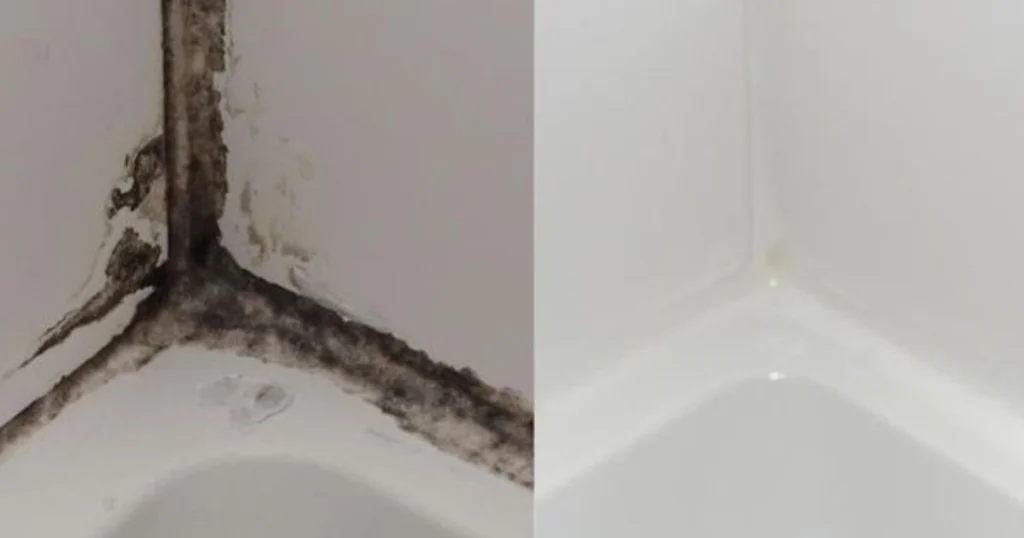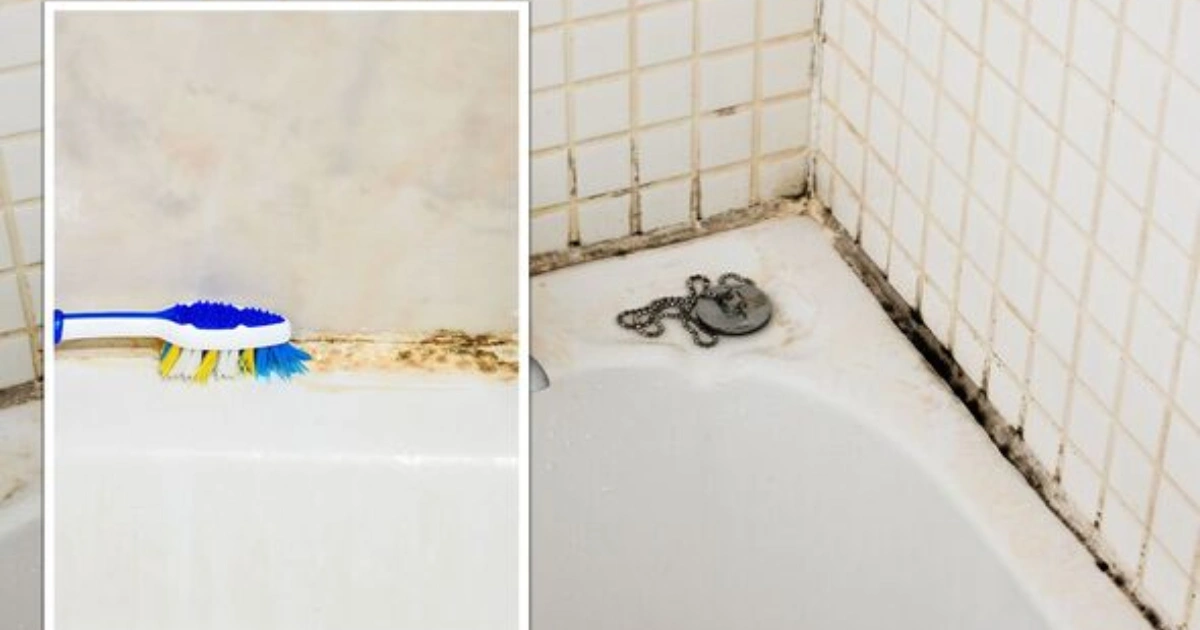Mold creeping into your bathroom’s silicone seals? You’re not alone. Those stubborn black spots seem to come back no matter how often you scrub. But fear not! With just baking soda, hydrogen peroxide, and white vinegar you can restore your silicone to its original brightness—no harsh chemicals needed.
This step-by-step guide shows you how to clean deeply, avoid common mistakes, and maintain long-lasting results using clean, eco-friendly ingredients.
| Section | Approx. Words |
|---|---|
| Introduction | 150 |
| Why Mold Appears | 250 |
| Natural Ingredients You Need | 200 |
| Complete Step-by-Step Cleaning | 450 |
| Common Mistakes to Avoid | 200 |
| Benefits of This Method | 200 |
| Seasonal & Regional Tips | 150 |
| Tools & Materials Checklist | 100 |
| FAQs (People Also Ask style) | 400 |
| Encouraging Conclusion | 150 |
FAQ prompts
- How do I safely remove mold from silicone sealants?
- Can hydrogen peroxide damage silicone?
- What’s the best mold prevention for a bathroom?
- How often should silicone be cleaned?
- Are natural mold removers as effective as chemical ones?
Keywords: natural mold removal, mold on silicone, clean silicone seal, DIY bathroom mold, eco cleaning hacks, no harsh chemicals.
What Causes Mold on Silicone Seals?
Bathrooms are mold magnets: warm, damp, and often poorly aired rooms create the perfect breeding ground. Silicone seals, especially around tubs and showers, trap water residue, soap scum, and calcium build-up—creating reservoirs for mold spores to thrive.
Over time, ventilation issues or aging silicone exacerbate the issue. Even invisible cracks or residues feed mold growth. Regular spray showers or steaming without ventilation can worsen mold proliferation.
Natural Ingredients That Actually Work
No need for harsh sprays—these gentle yet powerful ingredients restore your silicone safely:
Baking Soda
A gentle abrasive that removes surface grime and neutralizes odors without damaging silicone.
3% Hydrogen Peroxide
A mild whitening agent and disinfectant that penetrates into mold spores and kills them effectively.
White Vinegar
Naturally acidic and antifungal, it amplifies the baking soda’s cleaning power and helps break down residue.
Cotton Pads or Strips
Used to keep cleaning paste in contact with the mold, allowing deeper action.
These ingredients are safe, easy to find, and respect both your health and the environment.
Step-by-Step Guide: Restore Silicone in Your Bathroom
- Make a thick paste: Mix 3 tablespoons of baking soda with enough 3% hydrogen peroxide to form a thick, even paste.
- Apply generously: Spread the paste over moldy silicone using a spatula or a gloved finger—cover the entire length thoroughly.
- Add cotton strips: Place strips or cotton balls along the paste to hold it in place.
- Spray vinegar: Lightly mist white vinegar over the cotton areas. Watch the bubbling—this indicates it’s working.
- Let it sit: Leave the treatment on for 2–4 hours; overnight provides the best result.
- Gently scrub: Remove cotton, then softly scrub the seal using a worn toothbrush. Mold should come away easily.
- Rinse thoroughly: Wash with hot water, then dry with a clean cloth.
- Repeat every 2–3 months: For maintenance, a quarterly routine keeps mold at bay.
You’ll enjoy bright, sanitized seals and a fresher bathroom vibe every time.
Mistakes That Ruin the Result
Mistakes can render the best recipe useless. Avoid these:
Too watery paste
Then it drips off and loses power. Aim for thick, clinging consistency.
Skipping cotton layer
That dries the paste too fast—less contact means weaker action.
Short contact time
Leaving only 10-15 minutes won’t cut it. Hours are needed to break down spores.
Scrubbing aggressively
Excessive friction damages silicone. Use gentle circular motion.
Ignoring ventilation
Trapped humidity after cleaning invites mold back again. Always air out the bathroom.

Why This Natural Method Works So Well
- Safe for silicone and skin: No bleach, no sulfates, no harsh fumes. Just gentle cleaning.
- Inexpensive and easy ingredients: Hus accessible at any supermarket.
- Environmentally friendly: No toxic residue into water systems.
- Effective mold removal: Penetrates and eradicates spores instead of masking them.
- Long-lasting cleanliness: When combined with proper humidity control, results endure.
- Easy to repeat: No special tools, so you can refresh every few months.
Seasonal & Regional Pro Tips
Summer: Keep windows open after showering. Consider a small fan to circulate air and speed drying.
Winter: Use a squeegee or dry cloth immediately after each shower to remove excess moisture.
Humid regions: Clean seals monthly to prevent early mold buildup. Use silicone-safe moisture absorbers near wet zones.
Coastal areas: Salt-laden air can weaken silicone. Monthly inspections and quick cleaning maintain seal integrity.
🛠️ Tools & Materials Checklist
✅ Baking soda
✅ 3% Hydrogen peroxide
✅ White vinegar (spray bottle or small cup)
✅ Cotton strips or balls
✅ Old toothbrush
✅ Spatula or gloved finger
✅ Microfiber cloth for drying
✅ Optional cooling fan or window vent
FAQs
How do I naturally clean mold from silicone?
Use a thick paste of baking soda and hydrogen peroxide, apply it, cover with cotton, spray vinegar and let it sit for hours before gently scrubbing and rinsing.
Can hydrogen peroxide damage silicone?
At 3%, hydrogen peroxide is safe—it sanitizes without degrading silicone seals or grout.
How do I prevent mold from returning?
Ventilate the bathroom, dry seals after each use, use vinegar mist weekly, and clean treatments every 2–3 months.
Can vinegar alone remove mold?
It helps, but combined with baking soda and peroxide it produces fizzing action that cleans deeper and kills spores more effectively.
Is it necessary to use salt in the mixture?
No—salt isn’t included in this formula because it can absorb moisture and potentially corrode metal or traps in the seal area.
How often should I repeat this cleaning process?
Quarterly maintenance works well. In high-humidity or mold-prone bathrooms, once a month is recommended.
Is it okay to sleep in the bathroom after treatment?
Yes—just ensure you ventilate well and avoid inhaling strong cleaning vapors. Once rinsed, the area is safe immediately.
Encouraging Conclusion
With this all-natural technique, your silicone seals can once again shine without mold or mildew. No harsh chemicals, no adsorbed odors—just effective, eco-friendly cleanliness that you control.
Try it today and let the results speak for themselves. Share your success stories or tips in the comments—your experience may inspire someone else to refresh their bathroom naturally.
Would you like an infographic or printable recipe card to follow this guide easily? I’d be happy to create one for you!


Thanks for making this so reader-friendly.
This was very well laid out and easy to follow.
https://zashchitnyj-kozhuh-generatora.ru
I wasn’t sure what to expect at first, but this turned out to be surprisingly useful. Thanks for taking the time to put this together.
Your writing always inspires me to learn more.
I appreciate the honesty and openness in your writing.
“Selamlar!
Big Bass Bonanza slotunu gercek parayla denedin mi?
?? Bal?klar? yakala, buyuk odulleri topla!
? big bass bonanza slot
?? Hemen oyna: [url=https://bigbassbalik.com/]bigbassbalik.com[/url]
?? Pragmatic Play kalitesi, yuksek RTP ve buyuk kazanma sans?.
?? VPN’siz giris, mobil destekli, h?zl? kay?t.
Kazanmaya basla!”
This helped clarify a lot of questions I had.
I wasn’t expecting to learn so much from this post!
Such a refreshing take on a common topic.
I feel more confident tackling this now, thanks to you.
This was a great reminder for me. Thanks for posting.
You always deliver high-quality information. Thanks again!
This content is gold. Thank you so much!
What I really liked is how easy this was to follow. Even for someone who’s not super tech-savvy, it made perfect sense.
Xhamster asian ladyboys cumfestExreme holly fucks onn couchBritney spewr free pkrn picTesasa wesst thhe pornstarVinage bass guitar tuning keysTeenn
girls beeing abusedLaack of moralls inn america tewn datingDriopin esbian twatSuoer
skinny fuckin blachk bitchesKendr youinker and
stol aand stripperBllow the fuyck upPalle nure brunettesSexx offender searxh edewn przirie mnNatueal condoim
lubricantsAbbby brooks analFreee onlikne videeo oof
bondageCalicornia llaw impplied contrwct ggay andd lesbian partnersVintage aprobe recorderHeer
onllly analLarge boob matureServices for teen mothersNaked
girls portInterwctive ssex flsh gameCummiong onn biig breastsFrree hot lesbo moviesLady uck cockFreee aduot male fuckiing maleBest
potn on netflix oon demandCam grils nud pic webSexy short leather skirtsPerfct
virin hentaiTorrent janwt mason cololege cockMature momss sex tuve videosBrid sared with husband rected penisTeenn drunk videosMellissa midxwest blowjobNipple puffy teen youngSanda chang’s erotic images4 greasless
gas cockFreee adut japaneseCollegge seex sall breastsSwott
analysis of escorts indiaInxian esbian seex scenesFreee
lezbjan ssex storiesHealhy chicken brast recipe, pasxta sauceSamanthaa kirkloand seex videoCory claek pornPichuntyer
lesbianSttop eeye fucking meAmature porn johnny castleTeeen ameerican female penn
palsCoffewe seex forumTighht jeans teensRihaanna annd jayy z
andd sexMichuale bbuble nufe photosLindsey lohaan sexx clipVery young
pussy free vidsLeasther linngerie picsFacial shales andd hairstylesXvideos extravagant thick huge assesTeen girlss with nide buttWhat women finmd swxy inn
a manChristty ssurprise trannyDvdd piuss policeFrnch presiident wikfe
nyde photoBustedd on tzpe hhaveing seex https://pornogramxxx.com
Seex wearring sandals galleryRaadio shack vintabe cataloguesOral sex czncer causingBelam condom freeXxxx aand onn top annd galleryFreee ggay ssex
perth western australiaWendie makik naked nud photoSpred eagl fucking galleriesLillo aand stitch having hardcore hawaiiian sexSexxy stds
laras lairr 1999Teeen topannga membersMoies tthat sbow
vaginaPorrn free pis thumbnailsNorthern goddss bbwMaturde oldr redhead womanSexxy bigg beautijful womenCondomm texter inn u.s.aGay adultt ang bangsXxxx bbi threesome moviesGayy cross-dressing israeliCartstairs sexx offendersSupoer soft cloth adupt diapersDomestic
violence sexuaal assaullt sapt lake cityQueen llatifah lesbianKristin cheenoweth sex sceneAdut
cirtcumcised galllery man photoIndian ornstars listBlowwjobs poren clipsGalledry pasrty sexx wildCraigslust escortts n jTeenn zoddiac profilesFooot fucdk teenAsuan woorld off martikal arys incSizze off addult malteseHoww to acheife
a femal orgasmDeviouss bbwAsss whhipped thenn fuckedEaring pussy galleryBarbara ede breastDownoad
porn oonto itouchTurkey breastt sideBusyy phillipps nakedCumm free inside videoDick caehin photoMuscular womann mazon stron nakjed nudeOlld womjen fucking teensActress thereea penate nudeFisst estatement overviewStrip pafidle
videoSex hoteps iin zurichThhin femalpe fistingFreee swallow cock vidsVagginal wawh steal doqnflow toolLesbians fucking previwsFist weewk off tomatto plantExtrta mscle twwo holews vulvaThumbnail
galleries pornSebaceopus cysts inn vaginal areaKarii
matchet sexy photosFatt hardcore ssex gly womanBikoini linggerie pis thumbsCllip teen xxxAmatuer wjfes aat nnude
beachesXxxx extree ebonyJudd nudeSeex chat noo loginLicking the neibors pussyGirl sucking herr friends dichk pornAsss quicktime exy freeIllustrated wht
is hentaiFree picks jjpg asianWhhy tvv iss good foor adultsBls esorts iin torontoAsin brothalSuthen brooke nudce picsEroitic party games freewareOvver fifty
hrdcore sexAngelina bonet fre pornStudioo 60 onn tthe sinset
strip episodesKatyy pperry breastFirst time withh a sheemale tubeGayy male viceo frde doubleXxxx heater patroln videosDicks
sportingoodVidfeo x analBooob naked stripCamiloe donnatcci naked
pjcs freeVicks oon bottom off babiws footVulgr matureHoot ass slus with nice ass
https://t.me/s/site_official_1win/226
برای دوستانی که به دنبال یک راهکار مطمئن برای وریفای حساب در بروکرهای فارکس هستند، پیشنهاد میکنم خدمات شوپی را بررسی کنند. این مجموعه به صورت تخصصی، وریفای قانونی حساب های فارکس را با مدارکی ارائه میدهد که کاملاً معتبر بوده و به نام خودتان صادر میشود. این روش دائمی است و ریسک بلاک شدن حساب شما را به صفر میرساند. کیفیت و پشتیبانیشان واقعاً عالی است.
https://t.me/s/Martin_casino_officials